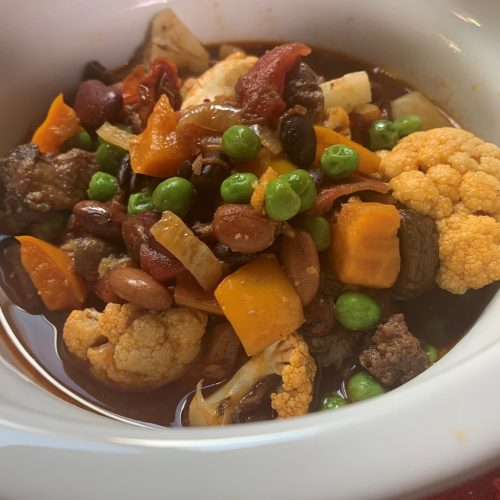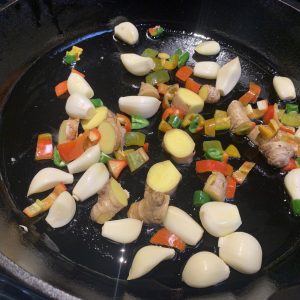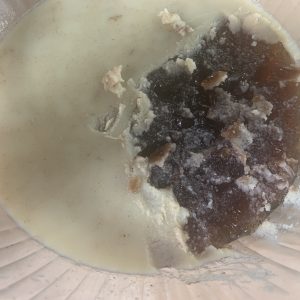Flavor and collagen packed oxtail chili with vegetables

Make for the taste & flavor and take in goodness of collagen
For me, nothing says warm and gelatinous goodness like an oxtail soup. And, this time, to amplify plant-based proteins, I decided to try it with three different kinds of beans in addition to usual root vegetables and aromatics and spices (like those in Goodness Basics). The combination added levels of complexity to texture and flavor that are unique and satisfying. It also increased bonus points that will help with joint & bone health.
I chose the ingredients first and foremost for their tastes and flavors. It looks, though, they also provide anti-inflammatory benefits. Numerous articles from Cleveland Clinic, Living Strong, Medical News Today, and Verywell Health suggest ingredients like bone broth, beans, garlic, onions, ginger, turmeric, bright colored and cruciferous vegetables help support joint health. It’s a nice bonus, but that’s not why I labor through to make this meal – it’s a pure joy to taste the complexity of amalgamation of all the ingredients working hard.
“How to” in a nutshell
The whole process is highly involved because it usually takes 2 days to make it. However, the techniques are fairly basic. In short, you would:
- Sauté aromatics (garlic, ginger, peppers) in olive oil to extract flavors.
- Sear oxtail pieces in the same pan on all sides.
- Transfer them to a large pot and add broth to cook oxtail for 3-1/2 to 4 hours.
- Skim the fat off the frying pan and deglaze with red wine, and add to the pot.
- Fish oxtail pieces from the pot and break the meat into small pieces.
- (Likely the following morning) skim the fat on the surface from the bone broth. You’ll see the “broth” is a pure gelatin!
- To get the most collagen out of the bones, I usually cook separated bones for the 2nd time in a small pot, scrape off gelatins, and add to the pot.
- Parboil beans up until they are somewhat soft but still firm.
- Sauté onions, aromatics, and root vegetables, add back the bone broth, and parboiled beans.
- Add cruciferous vegetables like cauliflowers, broccolis, and kale a few minutes before you finish.
For me, the satisfying and multi-faceted textures and flavors more than make up for the efforts. You can add barley or other grains in the pot, or cook quinoa separately and add right when you eat it. My favorite topping is crème fraiche, and sour cream will be nice, too.



Essential tips for delicious soup – aku-tori and otoshi-buta
Growing up in Japan, an indelible lesson for making great tasting soups handed down from elders is a step called “aku-tori.” That is, right before the broth reaches a boiling point, you must capture scums and excess fat that start gathering in the middle and skim them off before they start dissipating once the pot starts boiling. To do this, you can simply use a flat slotted ladle, or a tool called “aku-tori”, which is a shallow sieve made of fine mesh. The step ensures that your soup does not carry a hint of bitter, unpleasant taste. And, if you are making a consommé type soup, the broth stays clear.
After moving to the U.S., I also started adding a step of covering a soup or stew with an inner lid (called “otoshi-buta” in Japanese) made of either parchment paper or aluminum foil. It aids the liquid to circulate and sufficiently cover the ingredients without swimming in it. This step also is helpful in peeling off excess scums after the initial aku-tori when you remove it.


Different ethnic versions
Sometimes I also make a Korean version of oxtail soup “sokkoritang.” The soup itself is deliberately make rather plain, often with oxtail meats, broth, garlic, and daikon radish. And often when you eat it, you add condiments like kimchi, yellow bean sprout salad, etc. I’ve yet to make a Jamaican version and I plan to give it a try.
The recipe is for 12 servings and you can make it even in a bigger batch. The taste and flavor sustains after freezing and thawing. Hope you have a chance to try the way you like it!

Flavor and collagen packed oxtail chili
Ingredients
Oxtail broth
- 4 lbs oxtails large, meaty pieces with bones. About 5-7 pieces.
- 1 head garlic peal and use whole cloves
- 1 piece ginger root cut to about 1" pieces
- 2 pieces Fresno peppers cut into small pieces
- 2 tbsp olive oil
- 6 cups beef broth can use chicken broth or just water
- 1-1/2 cups red wine
Beans – cook with a pinch of salt until they are tender but not mushy
- 1 cup dried kidney beans soak in water for 6-8 hours and cook for about 45 min,
- 1 cup dried pinto beans soak in water for 6-8 hours and cook for about 40 min.
- 1 cup dried black beans soak in water for 4 hours and cook for about 25 min.
Vegetable mix
- 2 yellow onions quartered and sliced thin
- 2 sweet potatoes 1 if it's a large piece
- 2 orange bell peppers can be any color
- 3 golden beats
- 1 lbs cremini mushrooms
- 7 cloves garlic peel and slice
- 1 tbsp olive oil
- 1/4 cup red wine to deglaze with mushroom
Spice mix
- 1/2 tbsp cumin
- 1 tbsp turmeric
- 1 tsp cayenne pepper
- 1 tsp hot paprika
- 1/2 tbsp crushed red peppers
- 1 tsp coriander
- 1 tsp cardamom
- 1 tbsp maple syrup can use honey, brown sugar, or maple sugar
- 1 tsp salt
Aromatics
- 1 head garlic pealed and sliced thick
- 1 ginger root about 2" piece, cut in 1/2" pieces
- 2 sprigs oregano
- 5 sprigs thyme
Soup mix (in addition to oxtail bone broth)
- 4 cups water
- 30 oz diced tomatoes about 2 cans
- 6 oz tomato paste
- 1 tsp salt
Addition right before eating
- 1/2 head cauliflower
- 1/4 cup green beans
Instructions
Make oxtail broth – Day 1
- Pat dry oxtail pieces on both sides and sprinkle a healthy dose of salt & pepper on both sides.

- Sauté aromatics – Heat 2 tablespoons of olive oil in an iron skillet or a heavy pan at a medium heat, and sauté garlic, ginger, and Fresno (or other) peppers until the garlic turns golden brown.

- Sear oxtails – Raise the heat to medium high and sear oxtails on all sides, for 3-5 minutes each, until they turn brown & crisp.

- Deglaze the pan – after removing the seared oxtails, let the pan cool for 5 minutes. Drain excess fat, return to the medium heat, and deglaze with red wine. Add to the broth.

- Make a bone broth – Transfer all the pieces in a large soup pot and add 6 cups of beef broth (can be chicken or water) and put on a medium high heat. Once it's close to reaching a boiling point, make sure you skim the scum and excess fat. Continue to cook oxtail for about 3-1/2 to 4 hours until the meats are almost falling off the bones.

- Separate meats/bone and broth – fish out oxtails from the soup and once it's cooled, break the meats into small pieces. Let the broth cool and store in a fridge for several hours or overnight.

- If there are more gelatins left on the bones, place them in a small pot, add water and cook for another hour or so. Set the broth aside in a fridge to add to the soup pot later.
Soak the beans – Day 1 or early Day 2
- Soak dry beans separately – about 6-8 hours for kidney and pinto beans, and about 4 hours for black beans, in the 4 cups each of water.
Parboil beans
- Kidney and pinto beans – cook separately in about 6 cups each of water with a pinch of salt for about 40-45 minutes until they are soft, but still firm.
- Black beans – cook in about 6 cups of water with a pinch of salt for about 30 minutes until they are soft, but still firm.
Skim the fat from the bone broth
- Once the surface fat is hardened, skim off the fat from the broth.

Sauté aromatics and vegetables
- Prepare aromatics – peel garlics and slice lengthwise. Slice ginger roots. Separate oregano and thyme leaves from the stems.
- Prepare root vegetables – cut onions, sweet potatoes, golden beets, orange bell peppers, and mushrooms in about 1/2" pieces.
- Mix all the spices, except for maple syrup.
- Sauté garlics and ginger – heat a large skillet in medium heat, and add olive oil. Once it's heated, add garlic and ginger spices. Once the garlics turn golden brown, fish both garlics and ginger out and transfer to a large soup pot.
- Sauté onions and root vegetables – In the same skillet, sauté onions until they are light brown. Transfer onions to the soup pot. Add sweet potatoes, orange bell peppers, and beets to the skillet, and after a few minutes, add in spice mix and oregano & thyme. If the skillet becomes too try, add a little bit of broth. Transfer them all to the soup pot.
- Sauté mushrooms and deglaze the pan – finally, add mushroom and red wine to the skillet and cook mushroom for a few minutes. Transfer mushroom and deglazed juices to the pot.
Cook vegetables and beans and add bone broth and oxtails
- Drain the beans.
- Add 4-6 cups of water to the soup pot. It should come up to about 1" above the surface of the vegetables. Place the pot over a medium high heat.
- Right before the pot starts boiling, skim the scum and add maple syrup, diced tomatoes and tomato paste. Turn the heat down to medium low and cook for about 5 minutes.
- Add the oxtail bone broth and beans. Let them cook for about 10-15 minutes, or until the sweet potatoes are somewhat soft.
- Add oxtail meat pieces and continue to cook for 10 minutes. Taste and adjust the levels of salt and spices.
Let the soup stand for a few hours and finish it up
- Once the soup settled after a few hours, take the portion you will eat on the day in a smaller pot.
- Add cauliflower (or other cruciferous vegetables and/or green beans) to the pot and cook for a few minutes
- Serve in a large soup bowl and add your favorite topping (like crème fraiche) – now you are ready to eat.
- Freeze the rest in small batches.
Nutrition
About The Author
Related Posts
Roasted cruciferous with walnuts, mushrooms, and double garlic
Plant based dish loaded with flavors and textures We love cruciferous vegetables (broccoli, cauliflower, Brussel…
May 3, 2022Easy miso soup with tofu, kimchi, and daikon
If you want to try out Asian ingredients like miso, tofu, kimchi, and gochujang, this…
April 14, 2022



Leave A Comment